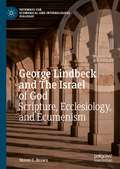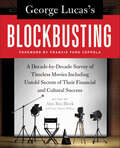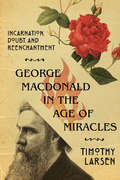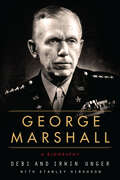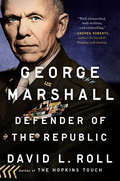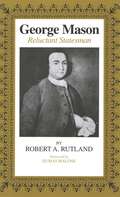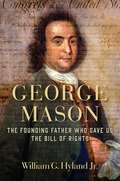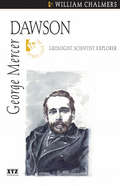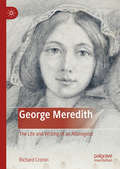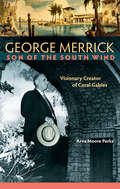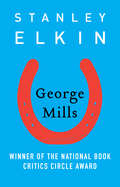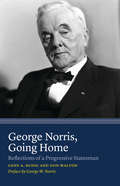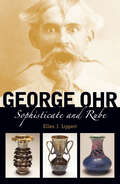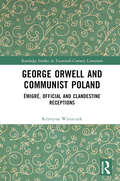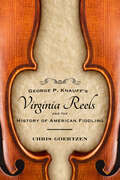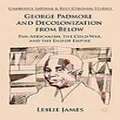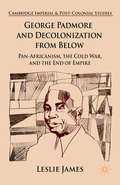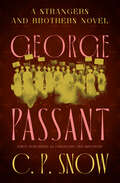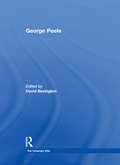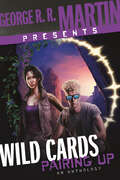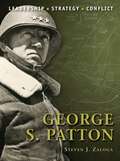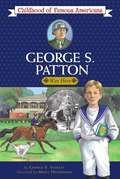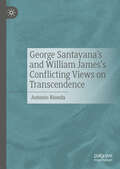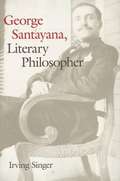- Table View
- List View
George Lindbeck and The Israel of God: Scripture, Ecclesiology, and Ecumenism (Pathways for Ecumenical and Interreligious Dialogue)
by Shaun C. BrownGeorge Lindbeck lamented that his most widely read work, The Nature of Doctrine, had often been read apart from his ecumenical focus. In this book, Shaun Brown seeks to provide a corrective to misreadings of Lindbeck’s work by focusing upon his “Israelology”—his emphasis upon the church and Israel as one elect people of God. While many Christians after the Holocaust have noted the harm that Supersessionism brought to the Jews, Lindbeck focuses upon the harm that supersessionism has brought to the church. He argues the appropriation of Israelhood by the church can bring intra-Christian ecumenical benefits. This work comes in two stages. In the first stage, undertaken while he was an observer at the Second Vatican Council, Lindbeck discusses a parallel between Israel and the church. The second stage, which begins in the late 1980s and continues through the end of his career, Lindbeck describes the church as “Israel-like” or “as Israel.”
George Lucas's Blockbusting: A Decade-by-Decade Survey of Timeless Movies Including Untold Secrets of Their Financial and Cultural Success
by Lucy Autrey Wilson Alex Ben BlockA comprehensive look at 300 of the most financially and/or critically successful motion pictures of all time—many made despite seemingly insurmountable economic, cultural, and political challenges—set against the prevailing production, distribution, exhibition, marketing, and technology trends of each decade in movie business history.
George MacDonald in the Age of Miracles: Incarnation, Doubt, and Reenchantment (Hansen Lectureship Series)
by Timothy LarsenThe Bible is full of miracles. Yet how do we make sense of them today? And where might we see miracles in our own lives? In this installment of the Hansen Lectureship series, historian and theologian Timothy Larsen considers the legacy of George MacDonald, the Victorian Scottish author and minister who is best known for his pioneering fantasy literature, which influenced authors such as C. S. Lewis, J. R. R. Tolkien, G. K. Chesterton, and Madeleine L'Engle. Larsen explores how, throughout his life and writings, MacDonald sought to counteract skepticism, unbelief, naturalism, and materialism and to herald instead the reality of the miraculous, the supernatural, the wondrous, and the realm of the spirit. The Hansen Lectureship series offers accessible and insightful reflections by Wheaton College faculty members on the transformative work of the Wade Center authors.
George Marshall: A Biography
by Irwin Unger Debi Unger“Elegant and iconoclastic . . . refreshing . . . persuasive.”—NEW YORK TIMES BOOK REVIEWHere is the first biography to offer a complete picture of the life of George C. Marshall, chief of staff of the U.S. Army from 1939 to 1945 and the military leader who actually ran World War II for America as he oversaw all personnel and logistics.Following Marshall from his childhood in western Pennsylvania and his training at the Virginia Military Institute to his role during and after World War II and his death in 1959 at the age of seventy-eight, this biography casts light on the inspiration he took from historical role models, such as George Washington and Robert E. Lee, and his relationships with military brass, the Washington political establishment, and world leaders, from Harry Truman to Chiang Kai-shek. It also explores Marshall’s triumphs and defeats during World War II, and his contributions through two critical years of the emerging Cold War—including the transformative Marshall Plan, which saved Western Europe from Soviet domination, and his failed attempt to unite China’s Nationalists and Communists.Based on exhaustive research and filled with rich detail, George Marshall is sure to be hailed as the definitive work on one of the most influential figures in American history.“A grand but judicious biography of a fascinating man.”—Evan Thomas, author of Ike’s Bluff
George Marshall: Defender of the Republic
by David L. RollThe extraordinary career of George Catlett Marshall—America&’s most distinguished soldier–statesman since George Washington—whose selfless leadership and moral character influenced the course of two world wars and helped define the American century. &“I&’ve read several biographies of Marshall, but I think [David] Roll&’s may be the best of the bunch.&”—Thomas E. Ricks, New York Times Book Review • &“Powerful.&”—The Wall Street Journal • &“Enthralling.&”—Andrew Roberts • &“Important.&”—William I. Hitchcock • &“Majestic.&”—Susan Page • &“Engrossing.&”—Andrew J. Bacevich • &“Judicious.&”—Walter Isaacson • &“Definitive.&”—Kirkus Winston Churchill called him World War II's "organizer of victory." Harry Truman said he was "the greatest military man that this country ever produced." Today, in our era of failed leadership, few lives are more worthy of renewed examination than Marshall and his fifty years of loyal service to the defense of his nation and its values. Even as a young officer he was heralded as a genius, a reputation that grew when in WWI he planned and executed a nighttime movement of more than a half million troops from one battlefield to another that led to the armistice. Between the wars he helped modernize combat training, and re-staffed the U.S. Army's officer corps with the men who would lead in the next decades. But as WWII loomed, it was the role of army chief of staff in which Marshall's intellect and backbone were put to the test, when his blind commitment to duty would run up against the realities of Washington politics. Long seen as a stoic, almost statuesque figure, he emerges in these pages as a man both remarkable and deeply human, thanks to newly discovered sources. Set against the backdrop of five major conflicts—two world wars, Palestine, Korea, and the Cold War—Marshall's education in military, diplomatic, and political power, replete with their nuances and ambiguities, runs parallel with America's emergence as a global superpower. The result is a defining account of one of our most consequential leaders.
George Mason, Forgotten Founder
by Jeff BroadwaterGeorge Mason (1725-92) is often omitted from the small circle of founding fathers celebrated today, but in his service to America he was, in the words of Thomas Jefferson, "of the first order of greatness." Jeff Broadwater provides a comprehensive account of Mason's life at the center of the momentous events of eighteenth-century America. Mason played a key role in the Stamp Act Crisis, the American Revolution, and the drafting of Virginia's first state constitution. He is perhaps best known as author of the Virginia Declaration of Rights, a document often hailed as the model for the Bill of Rights.As a Virginia delegate to the Constitutional Convention in Philadelphia, Mason influenced the emerging Constitution on point after point. Yet when he was rebuffed in his efforts to add a bill of rights and concluded the document did too little to protect the interests of the South, he refused to sign the final draft. Broadwater argues that Mason's recalcitrance was not the act of an isolated dissenter; rather, it emerged from the ideology of the American Revolution. Mason's concerns about the abuse of political power, Broadwater shows, went to the essence of the American experience.
George Mason: Reluctant Statesman
by Robert A. RutlandGeorge Mason of Gunston Hall was a scholarly craftsman of government during America's crucial formative years. His Virginia Declaration of Rights provided a sense of purpose and direction to the rebellious colonies, and his vigorous insistence on the protection of personal liberties in the Constitution is reflected in the document's first ten amendments, the Bill of Rights. Fellow Virginian Thomas Jefferson said of Mason that he "was of the first order of greatness."Few Americans who have served their country, however, have met with as little recognition. Essentially a private person who cared nothing for political prestige, Mason had been overshadowed by the other founders of the Republic -- although most of them had turned to him for advice and direction. In a concise, cogently written biography, a distinguished historian restores the "reluctant statesman" to his proper place in the pantheon of America's greatest citizens.
George Mason: The Founding Father Who Gave Us the Bill of Rights (George Mason Lectures #Vol. Vi)
by William G. Hyland Jr.George Mason was a short, bookish man who was a friend and neighbor of athletic, broad-shouldered George Washington. Unlike Washington, Mason has been virtually forgotton by history. But this new biography of forgotten patriot George Mason makes a convincing case that Mason belongs in the pantheon of honored Founding Fathers. Trained in the law, Mason was also a farmer, philosopher, botanist, and musician. He was one of the architects of the Declaration of Independence, an author of the Bill of Rights, and one of the strongest proponents of religious liberty in American history. In fact, both Thomas Jefferson and James Madison may have been given undue credit for George Mason's own contributions to American democracy.
George Mercer Dawson
by William ChalmersDawson worked for the International Boundary Commission and the Geological Survey of Canada. He surveyed the 49th parallel, vast tracts of land in British Columbias Interior, and many rivers in the Yukon. He knew the value of the Klondike gold fields ten years before the rush of 1898.
George Meredith: The Life and Writing of an Alteregoist
by Richard CroninGeorge Meredith: The Life and Writing of an Alteregoist is not only a critical biography of the Victorian novelist and poet George Meredith but also a portrait of the novel in the later nineteenth century. Interweaving analysis of Meredith’s novels and poems with discussion of his life, Richard Cronin focuses primarily on the books Meredith read and wrote—arguing that novels by the end of the nineteenth century were shaped as much by the reading as by the experience of their writers. Cronin places Meredith’s novels in relation to the work of his contemporaries including Henry James, Thomas Hardy, and George Gissing. Organized thematically, the book explores Meredith’s personal side—including his hostility to biography, his origins as the son of a tailor, his marriages—as well as his reading habits, and the prose style that is the most complete expression of his strange but compelling personality.
George Merrick, Son of the South Wind: Visionary Creator of Coral Gables
by Arva Moore ParksThe story of developers selling off the Sunshine State is as old as the first railroad tracks laid across the peninsula. But seldom do we hear about the men who actually built a better Florida. In George Merrick, Son of the South Wind, South Florida historian Arva Moore Parks recounts George Merrick's quest to distinguish himself from the legions of developers who sought only profit.Helping to create the land boom of the 1920s, Merrick transformed his family's citrus grove just outside of Miami into one of the finest planned communities: the "master suburb" of Coral Gables. With a team of architects and city planners, he built homes for the growing middle class in the Mediterranean Style using local stone, and he invested in public infrastructure by designing and building parks and pools, trolley lines and waterways. He pledged land for a library and the university that would become the University of Miami. Hailed in national publications as a visionary, Merrick was green before green, a New Urbanist before the movement even had a name.As Coral Gables and Merrick prospered, he reinvested in education, affordable housing, and other progressive causes. But the Great Depression ravaged Miami, and Merrick's idealism cost him his fortune. He died with an estate worth less than $400.With unprecedented access to the Merrick family and mining a treasure trove of Merrick’s personal letters, documents, speeches, and manuscripts, Parks presents the remarkable story of George Merrick and the development of one of the nation’s most iconic planned cities.
George Mills (American Literature (dalkey Archive) Ser.)
by Stanley ElkinAn age-old family curse fuels this National Book Critics Circle Award winner: &“Elkin&’s imagination should be declared a national landmark&” (Paul Auster).Since the time of the First Crusade, every generation of the Mills family has been consigned by fate to an unfulfilling, servile existence. And each successive Mills has had a son, George, to perpetuate the family plight through history. Whether a stable hand in feudal Europe or a prisoner in an Ottoman harem, each George Mills falls prey to his hereditary misfortune—until the modern George Mills threatens to reverse this fate once and for all. Written with penetrating insight and wit, George Mills is an engrossing story of one man&’s salvation, and an unforgettable defense of free will in even the most overwhelming of circumstances. This ebook features rare photos and never-before-seen documents from the author&’s estate and from the Stanley Elkin archives at Washington University in St. Louis.
George Norris, Going Home: Reflections of a Progressive Statesman
by Gene A. Budig Don WaltonAfter forty years of congressional service, five terms in the House and five in the Senate, George William Norris (1861–1944) was going home to Nebraska. Norris had lost the 1942 Senate race and felt the defeat keenly. But as his train rolled westward, he was forcefully reminded of what his legislative efforts had wrought, from the Tennessee Valley Authority (TVA) to the Rural Electrification Act (REA), which brought power to the land unfolding before him. It is here that authors Gene A. Budig and Don Walton begin their journey with this great statesman, perhaps the last progressive Republican, a tireless champion of &“public power&” and the common man.This book carries readers back through Norris&’s career and accomplishments: the establishment of the TVA and the REA as well as the Twentieth Amendment to the Constitution and the shaping of Nebraska&’s unique unicameral legislature. Norris recalls the battles he waged, one of which landed him in John F. Kennedy&’s Profiles in Courage, and the alliances he formed with leading political figures of his day, from Fiorello La Guardia to Franklin D. Roosevelt. The result is a contemporary perspective on a man who fiercely defended the public interest and followed his convictions to the lasting benefit of his state and his country.
George Ohr: Sophisticate and Rube
by Ellen J. LippertThe late nineteenth-century Biloxi potter, George Ohr (1857–1918), was considered an eccentric in his time but has emerged as a major figure in American art since the discovery of thousands of examples of his work in the 1960s. Currently, Ohr is celebrated as a solitary genius who foreshadowed modern art movements. While an intriguing narrative, this view offers a narrow understanding of the man and his work that has hindered serious consideration. Ellen J. Lippert, in her expansive study of Ohr and his Gilded Age context, counters this fable. The tumultuous historical moment that Ohr inhabited was a formative force in his life and work. Using primary documentation, Lippert identifies specific cultural changes that had the most impact on Ohr. Developments in visual display and the altered role of artists, the southerner redefined in the wake of the Civil War, interest in handicraft as an alternative to rampant mass production, emerging tenets of social thought seeking to remedy worker exploitation, and new assessments of morals and beauty as a result of collapsed ideals all played into the positioning Ohr purposefully designed for himself. The second part of Lippert's study applies these observations to Ohr's body of work, interpreting his stylistic originality to be expressions of the contradictions and oppositions particular to late nineteenth-century America. Ohr threw his inspiration into being both the sophisticate and the “rube,” the commercial huckster and the selfless artist, the socialist and the individualist, the “old-fashioned” craftsman and the “artist-genius.” He created art pottery as both a salable commodity and a priceless creation. His work could be ugly and deformed (or even obscene) and beautiful. Lippert reveals that far from isolated, Ohr and his creations were very much products of his inspired engagement with the late nineteenth century.
George Orwell and Communist Poland: Émigré, Official and Clandestine Receptions (Routledge Studies in Twentieth-Century Literature)
by Krystyna WieszczekGeorge Orwell and Communist Poland is the first major account of George Orwell’s Polish reception during the Second World War and the Cold War era. It shows how Orwell, the epitome of a censored writer in the Soviet bloc, enjoyed a fulsome reception both outside and within communist Poland. It does so by developing a tripartite framework to study reception in conditions of state-imposed censorship, where three modes are likely to develop in response: émigré, official and clandestine.The book thus brings to light Orwell’s overlooked relationships with Polish exiles who informed his work and looked upon him not only as a writer but also a personal friend and political ally. They eagerly translated his works and sought multinational promotion, even behind the Iron Curtain. The volume argues that Orwell also experienced official reception, smuggled into state-controlled culture in officially accepted ways. Additionally, communist censorship files reflect his reception within the state apparatus. Finally, the book examines passionate clandestine responses to Orwell's writing and myth in diaries and letters from as early as under Stalinism and explores Orwell’s popularity among underground publishing networks, which enabled his works to become bestsellers.The book draws on sources in foreign languages and previously unseen material, including Orwell’s ‘lost’ letters to Teresa Jeleńska, the Polish translator of Animal Farm. The volume significantly broadens our understanding of Orwell’s life, work and legacy. It also contributes to discussions in English literature and comparative literature, literary exchanges, translation, reception and censorship and East European studies.
George P. Knauff's Virginia Reels and the History of American Fiddling (American Made Music Series)
by Chris GoertzenGeorge P. Knauff's Virginia Reels (1839) was the first collection of southern fiddle tunes and the only substantial one published in the nineteenth century. Knauff's activity could not anticipate our modern contest-driven fiddle subcultures. But the fate of the Virginia Reels pointed in that direction, suggesting that southern fiddling, after his time, would happen outside of commercial popular culture even though it would sporadically engage that culture. Chris Goertzen uses this seminal collection as the springboard for a fresh exploration of fiddling in America, past and present. He first discusses the life of the arranger. Then he explains how this collection was meant to fit into the broad stream of early nineteenth-century music publishing. Goertzen describes the character of these fiddle tunes' names (and such titles in general), what we can learn about antebellum oral tradition from this collection, and how fiddling relates to blackface minstrelsy. Throughout the book, the author connects the evidence concerning both repertoire and practice found in the Virginia Reels with current southern fiddling, encompassing styles ranging from straightforward to fancy—old-time styles of the Upper South, exuberant West Virginia styles, and the melodic improvisations of modern contest fiddling. Twenty-six song sheets assist in this discovery. Goertzen incorporates performance descriptions and music terminology into his accessible, engaging prose. Unlike the vast majority of books on American fiddling—regional tune collections or histories—this book presents an extended look at the history of southern fiddling and a close examination of current practices.
George Padmore and Decolonization from Below
by Leslie JamesFrom his base in London, the Trinidad-born Marxist, George Padmore, was a central figure ofmid-twentieth century pan-Africanism who became critically involved in debates about thenature and practice of European imperialism. Focusing on Padmore's political manoeuvring, Leslie James traces his politics through the ongoing influence of the Caribbean and thelegacy of the Garvey movement; the international communist movement and Sovietdecolonization; debates about fascism and colonialism; the new 'reform' rhetoric apparentin World War II; the beginnings of the Cold War; and, pivotally, post-war African politicsthat confronted a wealth of new dynamics including independent Ghana, apartheid SouthAfrica, and the Mau Mau Emergency in Kenya. Within the ideas and political practice of thisforthright man lie a number of common questions about the circulation of ideas, the shapeof black radical thought, and the weight of Cold War politics within the modern history ofEuropean imperialism and the end of empire.
George Padmore and Decolonization from Below: Pan-Africanism, the Cold War, and the End of Empire (Cambridge Imperial and Post-Colonial Studies Series)
by L. JamesThis book argues that the rising tide of anti-colonialism after the 1930s should be considered a turning point not just in harnessing a new mood or feeling of unity, but primarily as one that viewed empire, racism, and economic degradation as part of a system that fundamentally required the application of strategy to their destruction.
George Passant (The Strangers and Brothers Novels)
by C.P. SnowA wise, moving novel about a mentor and his protégé: &“The central character . . . is immensely appealing . . . a peculiarly haunting and sympathetic figure.&” —The New York Times In late 1920s England, Lewis Eliot is building a career in law and has found a mentor in George Passant. The quirky small-town solicitor&’s clerk has much wisdom to share from his years of experience—during which he has also managed to hold on to his idealism. Eliot is just one of the many young devotees drawn to Passant, hoping for guidance from the man who&’s always ready to extend a loan or a listening ear. However, the young men will have to learn to fly on their own—and come to Passant&’s aid themselves—in this absorbing novel by &“an extremely shrewd observer of men and society&” (Commentary). &“An enlightened discussion of questions of conscience and conduct and commitment. . . . Filled with the concerns which are so fundamentally and essentially a part of this writer&’s work and have attracted a firm following.&” —Kirkus ReviewsOriginally published under the title Strangers and Brothers
George Peele (The University Wits)
by David BevingtonDavid Bevington's volume on George Peele looks at the literary achievement of that dramatist and author, who was born in London some time around 1556-8, was educated at Oxford, and returned to London to become a prolific writer until his death in 1596. He died at the age of forty, in poverty, and was never far from the threat of debtors' prison throughout his adult life. Peele, like Greene and Marlowe, was caricatured in his immediate afterlife as the embodiment of a popular and thriving literary culture in London of the late sixteenth century: a world that was competitive and relentlessly unforgiving in its economic pressures, but also colourful, adventuresome, and vital. This volume collects together for the first time the best contemporary published work on Peele by a group of renowned scholars. They discuss Peele's Lord Mayor's Pageants, Court Entertainments, occasional poems, and his plays The Arraignment of Paris, The Old Wives Tale, The Battle of Alcazar, Edward I, David and Bathsheba, and Titus Andronicus. The essays are accompanied by David Bevington's substantial introduction which discusses Peele's life and works, particularly in the context of the other five University Wits.
George R. R. Martin Presents Wild Cards: An Anthology
by George R. MartinSuperheroes and villains do battle over the human heart in this delightful anthology featuring all-new stories from a wide range of contributors, all set in the Wild Cards universe, where an alien virus mutates some and grants superpowers to others, created by the #1 New York Times bestselling author of A Game of Thrones. An alien virus ravages the world, its results as random as a hand of cards. Those infected either draw the black queen and die, draw an ace and receive superpowers, or draw the joker and are bizarrely mutated.Nevertheless, human nature reigns supreme. And one of the most enduring human drives is the search for love. Aces and jokers alike both want to find it, or have lost it . . . or perhaps just want to use it for personal gain. Crazy, unconventional, touching, strange, and oh-so-familiar, this is love, Wild Cards-style.Within these stories:• A jewel thief seduces a popular actor just so she can track down a long-lost treasure.• A teenager trapped in the body of a giant snail attempts to win his love à la Cyrano de Bergerac.• A man discovers his purpose in life after meeting a beautiful butterfly woman.• A young hero who has been awarded the hideous name of Hero McHeroface finds some solace in the arms of an astrologer hiding her own unique powers.Pairing Up is the Wild Cards take on love—finding it, seeking it, losing it, or achieving it—as aces and jokers enter into the highest-stake game of all: gambling on their heart's desire.With stories by Kevin Andrew Murphy • Christopher Rowe • Marko Kloos • Melinda M. Snodgrass • Bradley Denton • Walton Simons • Peter Newman • Gwenda Bond • David Anthony Durham • Edited by George R. R. Martin
George S. Patton
by Steven Zaloga Steve NoonGeorge S. Patton Jr. was the iconic American field commander of World War II, and widely regarded as the US Army's finest practitioner of mechanized warfare. This title examines Patton's colorful life and leadership in three wars, with a concentration on his command in World War II. Despite his ability, Patton was thoroughly reviled by most GIs, partly due to his insistence on traditional military discipline in the ranks, but also because of his unwillingness to pander to the growing power of the press. This combination of ability and controversy have combined to make him one of the most interesting figures in American military history.Steven Zaloga's contribution to Osprey's newest series, Command, addresses this iconic figure from his early life to his life after war. Including an analysis of Patton's mind and motivations, strict training methods and the controversies surrounding Patton and his relationship with his soldiers and with Eisenhower, Zaloga's text is a concise but important look into the life of one of the most famous commanders of World War II.From the Trade Paperback edition.
George S. Patton: War Hero
by George E. StanleyChildren's fictionalized biography of the World War II hero.
George Santayana's and William James's Conflicting Views on Transcendence
by Antonio RiondaThis book studies the philosophical work of George Santayana and the nature of his work's relationship with that of American philosopher William James. James is consistently dismissive of “the ‘all is vanity’ state of mind,” which arguably represents the opposite of America’s activist, progressive ideals. The Spanish Santayana made the overcoming of vanity, or detachment central to his “vital philosophy,” which he had to gradually “disentangle” from the forces he found at work in America. This book, then, traces Santayana’s intricate response to James, from its earliest expression in Interpretations, to his later Realms. Rather than attempt to arrive at a final interpretation of either one’s philosophy, Antonio Rionda emphasizes what James refers to as the hotspot of each one’s thinking: James’s is best described as positivistic Existentialism, and Santayana’s as phenomenological intuitionism. Santayana’s post-Hegelian approach to doing philosophy allows for him to incorporate James’s major insights into his own thinking. The problem of how psychology relates to philosophy led Santayana to posit literary psychology as an alternative to its scientific variety, which once disentangled from James’s psychologism, represents the greatest virtue of James’s thinking.
George Santayana: Literary Philosopher
by Irving SingerGeorge Santayana was unique in his contribution to American culture. For almost sixty years before his death in 1952, he combined literary and philosophical talents, writing not only important works of philosophy but also a best-selling novel, volumes of poetry, and much literary criticism. In this fascinating portrait of Santayana's thought and complex personality, Irving Singer explores the full range of his harmonization of the literary and the philosophical. Singer shows how Santayana's genius consisted in his imaginative ability to turn various types of personal alienation into creative elements that recur throughout his books. Singer points out that Santayana was a professional philosopher who addressed immediate problems of existence, a materialist in philosophy who believed in both a life of spirit and a life of reason, a product of American pragmatism who nevertheless rebelled against it, a Spaniard who wrote only in English, an American author who spent the last forty years of his lift in different European countries. Against the grain of most twentieth-century philosophy, Santayana kept in view questions that matter to us all in our search for meaningful and satisfying lives.
